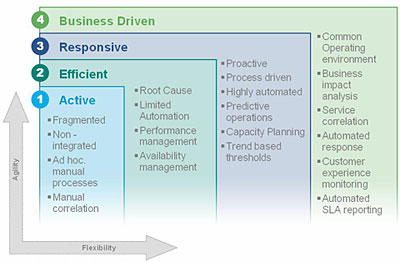|
|

article
page | 1 | 2 | 3 | 4 |
increases the demand for service quality as customers look to adopt an all or nothing approach to their services. As a result, the cost of churn for the CSP is growing rapidly as customers who once had one service at $40 per month now have three or more services at $150 per month. Accordingly, if quality of any service is not up to the subscribers expectations, then they will drop all three services. Service quality is also becoming a key differentiator against new competitive entrants that are looking to steal subscribers from the traditional CSP’s by offering cheaper solutions - typically aimed at one particular service (Voice, Video or Data). In the North American marketplace, this battle is playing out in real-time as traditional CSP’s continually advertise the quality of their service experience and non traditional entrant’s blast out ads for cheaper video or voice services.
|
|
Instrumentation needs to be incorporated into the resources, components and services to gather KPI’s, both quantitative and qualitative measures. |

performance information; however, the approach only achieves partial SQM as the measurement of the network and its performance does not provide a direct indication of the end subscriber’s experience. As an example, network performance typically involves gathering performance information from key points in the network every 5 minutes - information such as throughput, errors/discards, CPU utilization, etc. This is critical information for network resource capacity planning or proactive management of the network; however, it does not provide a mechanism to deduce the quality of a user’s
|
|
|
|

What role do standards play in SQM?
As CSP’s look to embrace the concepts of SQM, there is increased focus on standards bodies such as the TeleManagement Forum (TMF) to provide guidance, use cases, architectures and standards that vendors and CSP’s can leverage to ensure interoperability and a more plug and play implementation experience. Fortunately, TMF has responded with a series of initiatives around SQM, leveraging existing SLA focused areas. The SQM initiative within TMF is a combination of several projects that are now in the process of coming together. At a macro level the objectives address three key deliverables:
- What needs to be measured? (Methodology)
- How to measure it? (Architecture)
- How to use the measurements? (Process)
An interesting outcome of the TMF efforts is an increased investment by CSP’s in the network layer in an early effort to improve SQM. This makes perfect sense as the network provides the best source for key
|
|

session (voice, video or data) across the network. To address this weakness, CSP’s typically deploy probes or leverage internal testing agents within the network to create synthetic transactions to simulate actual user sessions. In combination with performance management systems, synthetic transaction measurements help provide a comprehensive quantitative measure of the network and the quality of services delivered. Unfortunately it’s not enough as customers continue to churn from their CSP’s due to poor service quality.
Morphing of Performance Management to Service Quality Management
The migration of performance management to service quality management closely aligns with the process maturity model (see graph). Initially, CSP’s had very simplistic approaches to performance management best described as red light, green light or basic availability monitoring. This provided a basic view of performance that was typically characterized by waiting for customers to call into customer care, then reacting to the outage. This
article
page | 1 | 2 | 3 | 4 |
|
|
|




